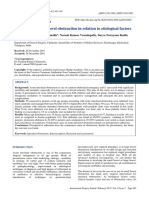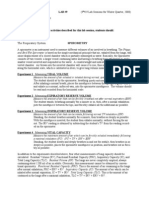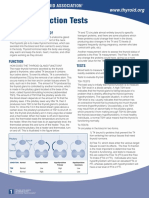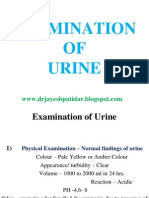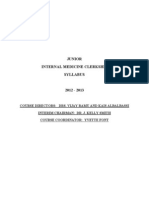0 ratings0% found this document useful (0 votes)
151 viewsAscites
Ascites
Uploaded by
rdjAscites is the accumulation of fluid in the abdominal cavity, most commonly caused by portal hypertension from liver cirrhosis. Other potential causes include malignancy or infection, which are important to differentiate for patient care. Symptoms include increased abdominal size and shortness of breath from respiratory compromise if massive amounts of fluid are present. Diagnosis involves physical examination, imaging, and paracentesis of fluid for characterization. Treatment ranges from sodium restriction for mild ascites to diuretic therapy for moderate amounts and procedures like repeated paracentesis or TIPS for larger volumes.
Copyright:
© All Rights Reserved
Available Formats
Download as PPTX, PDF, TXT or read online from Scribd
Ascites
Ascites
Uploaded by
rdj0 ratings0% found this document useful (0 votes)
151 views4 pagesAscites is the accumulation of fluid in the abdominal cavity, most commonly caused by portal hypertension from liver cirrhosis. Other potential causes include malignancy or infection, which are important to differentiate for patient care. Symptoms include increased abdominal size and shortness of breath from respiratory compromise if massive amounts of fluid are present. Diagnosis involves physical examination, imaging, and paracentesis of fluid for characterization. Treatment ranges from sodium restriction for mild ascites to diuretic therapy for moderate amounts and procedures like repeated paracentesis or TIPS for larger volumes.
Copyright
© © All Rights Reserved
Available Formats
PPTX, PDF, TXT or read online from Scribd
Share this document
Did you find this document useful?
Is this content inappropriate?
Ascites is the accumulation of fluid in the abdominal cavity, most commonly caused by portal hypertension from liver cirrhosis. Other potential causes include malignancy or infection, which are important to differentiate for patient care. Symptoms include increased abdominal size and shortness of breath from respiratory compromise if massive amounts of fluid are present. Diagnosis involves physical examination, imaging, and paracentesis of fluid for characterization. Treatment ranges from sodium restriction for mild ascites to diuretic therapy for moderate amounts and procedures like repeated paracentesis or TIPS for larger volumes.
Copyright:
© All Rights Reserved
Available Formats
Download as PPTX, PDF, TXT or read online from Scribd
Download as pptx, pdf, or txt
0 ratings0% found this document useful (0 votes)
151 views4 pagesAscites
Ascites
Uploaded by
rdjAscites is the accumulation of fluid in the abdominal cavity, most commonly caused by portal hypertension from liver cirrhosis. Other potential causes include malignancy or infection, which are important to differentiate for patient care. Symptoms include increased abdominal size and shortness of breath from respiratory compromise if massive amounts of fluid are present. Diagnosis involves physical examination, imaging, and paracentesis of fluid for characterization. Treatment ranges from sodium restriction for mild ascites to diuretic therapy for moderate amounts and procedures like repeated paracentesis or TIPS for larger volumes.
Copyright:
© All Rights Reserved
Available Formats
Download as PPTX, PDF, TXT or read online from Scribd
Download as pptx, pdf, or txt
You are on page 1of 4
ASCITES
• Ascites is the accumulation of fluid within the peritoneal cavity.
• Most common cause of ascites is portal hypertension related to
cirrhosis.
• Malignant or infections can also cause ascites
• Differentiation of these other causes are important for patient care.
Clinical Features
• Increase in abdominal girth. Accompanied by the development of
peripheral edema.
• Development of ascites is often insidious.
• Patients usually have 1-2 L pf fluid in the abdomen before they are
aware that there is an increase.
• If massive, respiratory function can be compromised causing shortness
of breath.
• Hepatic hydrothorax may also occur.
• Patients with massive ascites are often malnourishes and have muscle
wasting and excessive fatigue and weakness.
Diagnosis
• By physical examination aided by abdominal imaging.
• Patients will have bulging flanks, may have a fluid wave or presence of
shifting dullness.
• Subtle amounts of ascites can be detected by ultrasound or CT
scanning.
• Recommended diagnostic for patients with ascites for the first time
is paracentesis to characterize the fluid.
• In patients with cirrhosis, the protein concentration of the ascites
fluidis low, majority will have a concentration of <1g/dL.
Treatment
• Small amounts of ascites can be managed with dietary sodium restriction alone.
• <2g of sodium per day is recommended amount.
• Eat fresh or frozen food, avoiding canned or processed foods.
• Moderate ascites: diuretic therapy is usually necessary.
Spironolactone at 100 –200 mg/d as a single dose
Furosemide may be added at 40 –80 mg/d in patients with
peripheral edema.
• Alternative treatment including repeated large volume paracentesis or TIPS
procedure should be considered.
You might also like
- Esophageal Varices and AtresiaDocument20 pagesEsophageal Varices and Atresiax483xDNo ratings yet
- Hepatic Encephalopathy: Causes, Tests, and Treatment OptionsFrom EverandHepatic Encephalopathy: Causes, Tests, and Treatment OptionsRating: 3.5 out of 5 stars3.5/5 (2)
- Gastric Outlet Obstruction, A Simple Guide To The Condition, Diagnosis, Treatment And Related ConditionsFrom EverandGastric Outlet Obstruction, A Simple Guide To The Condition, Diagnosis, Treatment And Related ConditionsNo ratings yet
- Anatomy of ESophagusDocument28 pagesAnatomy of ESophagusAbdur RaqibNo ratings yet
- Arianna Mabunga BSN-3B Urinary Diversion DeffinitionDocument5 pagesArianna Mabunga BSN-3B Urinary Diversion DeffinitionArianna Jasmine Mabunga0% (1)
- 08 Acid-Base BalanceDocument12 pages08 Acid-Base BalanceLeonilaEnriquezNo ratings yet
- Bladder Outlet Obstruction in Children PDFDocument64 pagesBladder Outlet Obstruction in Children PDFalaaNo ratings yet
- Clinical Manifestations and Diagnosis of Urinary Tract Obstruction and Hydroneph PDFDocument32 pagesClinical Manifestations and Diagnosis of Urinary Tract Obstruction and Hydroneph PDFAmjad Saud0% (1)
- Chronic Obstructive Pulmonary Disease COPDDocument25 pagesChronic Obstructive Pulmonary Disease COPDKat Ortega100% (1)
- PBL Case - 2Document14 pagesPBL Case - 2Jerin XavierNo ratings yet
- First Aids For PoisoningDocument11 pagesFirst Aids For PoisoningGysha Puna TemudNo ratings yet
- Respiratory Function TestDocument7 pagesRespiratory Function TestMarivic DianoNo ratings yet
- Clinical Study of Bowel ObstructionDocument6 pagesClinical Study of Bowel ObstructionhorzhanNo ratings yet
- Pylonephritis 130520160226 Phpapp02Document17 pagesPylonephritis 130520160226 Phpapp02Elena-Dana OpreaNo ratings yet
- Congenital Heart Defects: Module F Chapter Eleven Cardiac System Pages 348 - 359Document48 pagesCongenital Heart Defects: Module F Chapter Eleven Cardiac System Pages 348 - 359Sasikala Mohan100% (1)
- Hypertension: Solomon E QuaysonDocument47 pagesHypertension: Solomon E QuaysonseadiabaNo ratings yet
- Participants Copy - Prevalence Prognosis and Pathophysiology of Pulmonary HypertensionDocument26 pagesParticipants Copy - Prevalence Prognosis and Pathophysiology of Pulmonary HypertensiondhilaNo ratings yet
- Thrombotic DisordersDocument25 pagesThrombotic Disordersiamtrcmrvr922No ratings yet
- Pancreatic Cancer: Pathophysiologic EtiologyDocument2 pagesPancreatic Cancer: Pathophysiologic EtiologyCharissa Magistrado De LeonNo ratings yet
- Dilated CardiomyopathyDocument27 pagesDilated CardiomyopathyPaula Vanessa RN100% (1)
- Disorders of Potassium Metabolism PresentationDocument20 pagesDisorders of Potassium Metabolism PresentationSolomon Fallah Foa SandyNo ratings yet
- Genitourinary: Drafnan Abdirahman MohamedDocument163 pagesGenitourinary: Drafnan Abdirahman MohamedMuse MuseNo ratings yet
- Acute Renal FailureDocument30 pagesAcute Renal FailureJerinNo ratings yet
- Cirrhosis in Adults: Overview of Complications, General Management, and Prognosis - UpToDateDocument21 pagesCirrhosis in Adults: Overview of Complications, General Management, and Prognosis - UpToDateDan ChicinasNo ratings yet
- Acid Base Balance Fluid BalanceDocument32 pagesAcid Base Balance Fluid BalanceLIDIYA MOL P VNo ratings yet
- Stomach CancerDocument15 pagesStomach Cancerpooran singhNo ratings yet
- Respiratory System CopDocument44 pagesRespiratory System CopAsad KHANNo ratings yet
- SPIROMETRYDocument5 pagesSPIROMETRYJayarubini JeyapalNo ratings yet
- Abdominal Paracentesis, AP, Abdominal TapDocument32 pagesAbdominal Paracentesis, AP, Abdominal TapMeraflor BahonsuaNo ratings yet
- Gastrointestinal DiseasesDocument19 pagesGastrointestinal DiseasesJune DumdumayaNo ratings yet
- Surgical Management of Urinary IncontinenceDocument30 pagesSurgical Management of Urinary IncontinenceSayantika DharNo ratings yet
- Gastric Outlet Obstruction (Stenosis) : Lior Shlomov 1852Document8 pagesGastric Outlet Obstruction (Stenosis) : Lior Shlomov 1852Lior ShlomovNo ratings yet
- Thyroid Function Test PDFDocument2 pagesThyroid Function Test PDFAlizaPinky100% (1)
- Suppurative Lung Diseases: DR Faisal Moidunny Mammu Department of PaediatricsDocument39 pagesSuppurative Lung Diseases: DR Faisal Moidunny Mammu Department of PaediatricsFaisal MoidunnyNo ratings yet
- Cyanotic Congenital Heart DiseasesDocument25 pagesCyanotic Congenital Heart DiseasesAlvin OmondiNo ratings yet
- Glomerulonephritis: Marivic J. MiagarDocument28 pagesGlomerulonephritis: Marivic J. MiagarMarivic DianoNo ratings yet
- Examination of UrineDocument18 pagesExamination of UrineDr. Jayesh PatidarNo ratings yet
- Disorders of The Kidneys and Ureters3962Document110 pagesDisorders of The Kidneys and Ureters3962Nikki M. Arapol100% (1)
- Diabetes Insipidus, Siadh and Cerebral Salt-WastingDocument33 pagesDiabetes Insipidus, Siadh and Cerebral Salt-WastingEuphrasiaNo ratings yet
- AchalasiaDocument11 pagesAchalasiarlinaoNo ratings yet
- INTUSSUSCEPTIONDocument3 pagesINTUSSUSCEPTIONS GNo ratings yet
- Fetal Circulation Anatomy and Physiology of Fetal Circulation Umbilical CordDocument3 pagesFetal Circulation Anatomy and Physiology of Fetal Circulation Umbilical CordbobtagubaNo ratings yet
- SYLLABUS Internal Medicine Junior ClerkshipDocument15 pagesSYLLABUS Internal Medicine Junior ClerkshipAloah122346No ratings yet
- Cardiogenic Pulmonary EdemaDocument1 pageCardiogenic Pulmonary EdemaAirish LimNo ratings yet
- Seminar On Acute PancreatitisDocument20 pagesSeminar On Acute PancreatitisJoice DasNo ratings yet
- Airway Management (Kuliah Panum)Document43 pagesAirway Management (Kuliah Panum)yudhaNo ratings yet
- Diagnostic Investigations of Cardiovascular System: A Presentation by Tejaswini MDocument70 pagesDiagnostic Investigations of Cardiovascular System: A Presentation by Tejaswini MKusum RoyNo ratings yet
- Acid Peptic Disorder and GerdDocument52 pagesAcid Peptic Disorder and GerdEbuka AniNo ratings yet
- Pyelonephritis: Dr. Shraddha Koirala Department of Pathology NMCTHDocument26 pagesPyelonephritis: Dr. Shraddha Koirala Department of Pathology NMCTHUrusha MagarNo ratings yet
- What Is A Gastrectomy?Document4 pagesWhat Is A Gastrectomy?Priyanka JangraNo ratings yet
- Renal Abscess, Xanthogranulomatous Pyelonephritis and Renal TuberculosisDocument41 pagesRenal Abscess, Xanthogranulomatous Pyelonephritis and Renal TuberculosisAnas Mk HindawiNo ratings yet
- 7 Pulmonary EdemaDocument10 pages7 Pulmonary Edemaomar kmr97No ratings yet
- Abdominal ExaminationDocument4 pagesAbdominal ExaminationdizhalfaNo ratings yet
- Ventricular Septal DefectDocument9 pagesVentricular Septal DefectpepotchNo ratings yet
- Pleural Fluid AnalysisDocument15 pagesPleural Fluid AnalysisNatalie Sarah MoonNo ratings yet
- BASIC LIFE SUPPORT Basics IntroductionDocument27 pagesBASIC LIFE SUPPORT Basics IntroductionMUKESH SUNDARARAJANNo ratings yet
- Cardiac TamponadeDocument10 pagesCardiac TamponadeRahmi Fatma SariNo ratings yet
- Hyperkalemia 1Document26 pagesHyperkalemia 1ksNo ratings yet
- An Approach To Coma.Document32 pagesAn Approach To Coma.Divya GNo ratings yet
- Surgical ComplicationsDocument41 pagesSurgical ComplicationsFrida AtallahNo ratings yet












